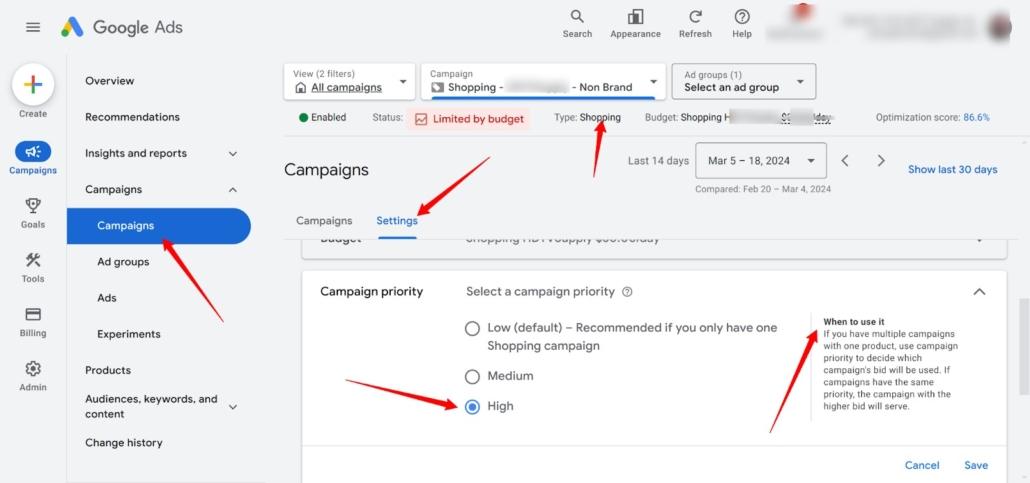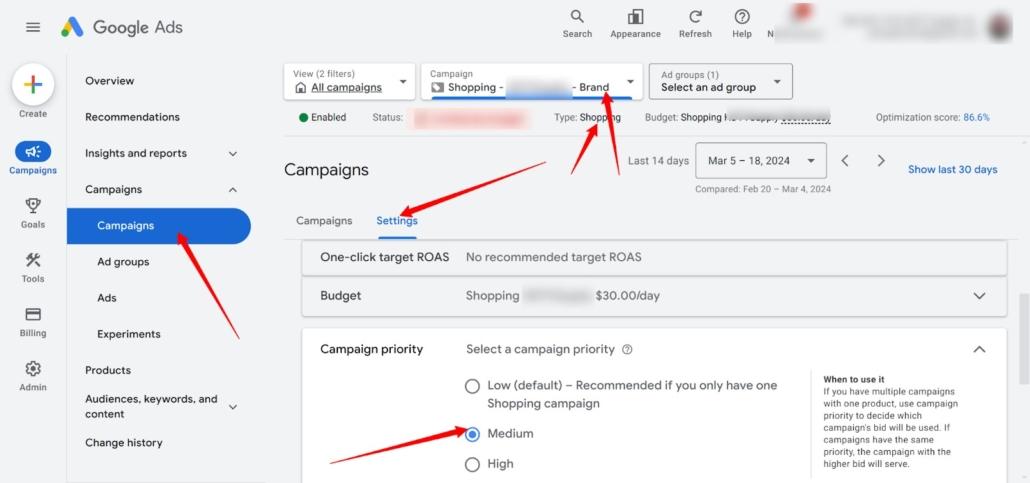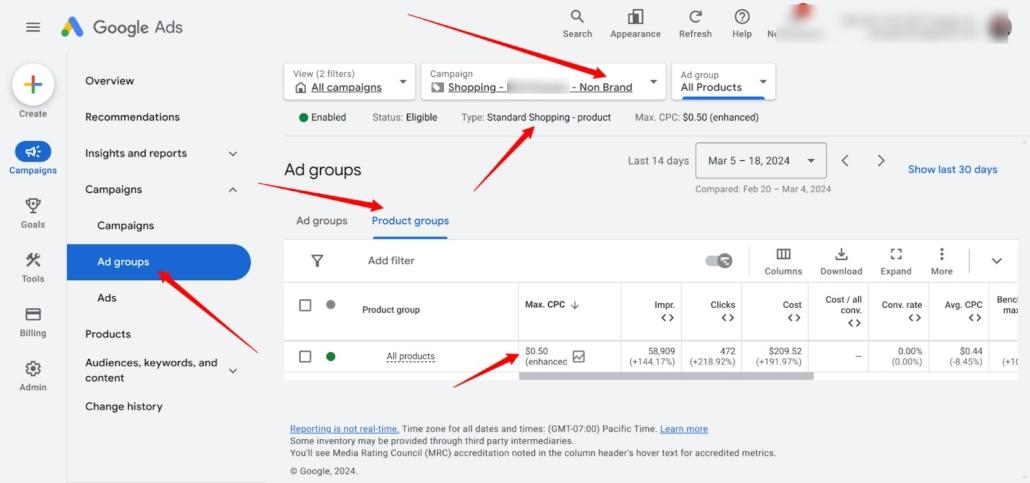How to Leverage Query-Level Bidding in Google Shopping Ad
Last Updated on March 23, 2024 by Subhash Jain
The Tiered Approach to Structuring Google Shopping Campaigns
The world of online shopping is booming, and with it, the challenge of getting your products to stand out has become tougher. But don’t worry, In the world of online advertising, particularly for Google Shopping, maximizing your return on ad spend requires precision. This is where query-level bidding comes. Query Sculpting is a Google Shopping-specific trick to achieve a similar effect. It uses multiple campaigns with identical products, but negative keywords, campaign priorities, and different bids act like a sculptor’s tools to control which queries each campaign shows ads for, while Query-Level Bidding lets you directly set bids for each search term triggering your ads.
Here’s where it gets interesting. Picture this: there’s no direct way to say, “Hey Google, show my ad for this specific search.” This might sound like a bummer, but
Here comes Martin Roettgerding to the rescue with his brilliant idea:
Query Sculpting. It’s like sculpting your ideal audience out of the vast internet crowd, ensuring your ads reach the right eyes.
“Query Sculpting isn’t just any strategy; it’s a game-changer. Martin figured out that by using negative keywords smartly, you could essentially guide Google on where your ads should and shouldn’t appear. It’s like setting up signposts for your ads, telling them, “Hey, go this way!” This method uses three levels of campaigns, each with its own job, from catching general interest to snagging those ready to hit the buy button.”
In simple terms, we’re breaking down the walls that keep your ads from reaching their true potential. By applying Martin’s strategy, you’re not just throwing your ads out there and hoping for the best. You’re strategically placing them where they’ll make the biggest impact. Query-level bidding” and “query sculpting” in Google Shopping Ads are closely related, they’re interchangeable.
So, let’s dive into this together and turn your Google Shopping campaigns into well-oiled machines, ready to reach the right people at the right time. With Query Sculpting, you’re not just another advertiser; you’re a master sculptor, shaping your path to success in the bustling world of online shopping.
What is Query-level Bidding/Query Sculpting in Google Shopping Ads?
Query-level bidding is a refined approach to managing your Google Shopping Ads. It involves adjusting your bids based on the search query’s specificity and potential to convert. This method allows for more granular control over your ad spend, targeting your budget towards queries that are more likely to lead to sales. Query sculpting takes the concept of query-level bidding a step further. It involves the strategic manipulation of shopping queries through the use of multiple campaigns, campaign priorities, and negative keywords. The goal is to direct the right bids to the right queries, ensuring that your ads are shown to users with the highest intent to purchase. This technique is crucial for advertisers looking to maximize the efficiency of their ad spend.
Why is Query-level Bidding needed?
Query-level bidding is not a direct feature within Google Shopping Ads but a strategic approach to bid management based on the specificity and value of search queries. It’s necessary because not all queries are created equal—some may indicate a high intent to purchase, while others might be more exploratory. This approach enables advertisers to allocate their budgets more efficiently, focusing on queries that are more likely to convert, thus improving the overall effectiveness of their advertising spend.
What is the purpose of Query Sculpting?
Query Sculpting: The Purpose and Benefits
Query Sculpting involves strategically structuring campaigns, utilizing campaign priorities, and employing negative keywords to direct your ad spend toward queries that are most likely to convert. The purpose is multifold:
- Enhanced Ad Relevance: By targeting queries more precisely, ads become more relevant to the user’s search intent.
- Improved Conversion Rates: Focusing on high-intent queries often leads to higher conversion rates, as the ads are reaching users closer to the purchase decision.
- Optimal Use of Budget: Reducing spend on generic or low-intent queries allows for more investment in queries with a higher conversion potential.
How can you set-up Up Query-Level Bidding In Your Googling Shopping Ads Account?
This graphic explains how to structure Google Shopping campaigns using a tiered approach. It shows a non-branded campaign with high priority settings and lower bids for non-brand keywords and a branded campaign with medium priority settings and higher bids on brand keywords. Both use shared budgets But negative keywords list only apply on non-branded campaigns and negative keywords are used to control spending and ad placement effectively.

Setting Up Query-Level Bidding in Google Shopping Ads
Embarking on query-level bidding and query sculpting might seem daunting, but with the right approach, it’s entirely achievable. Here’s how to get started:
Shared Budgets
Shared budgets are a foundational element in query sculpting. They allow you to allocate your budget across multiple campaigns, ensuring that your money is spent on the most effective queries.
Setting Campaign Priorities (Low, Medium, High)
Understanding and utilizing campaign priorities (Low, Medium, High) is crucial. These settings determine which campaign bids in an auction, based on the presence of the same product across multiple campaigns. The campaign with the highest priority bids first, with others following based on their priority level and available budget.
This determines which campaign out of your shopping campaigns should be eligible to show ads for a particular search term. Campaigns can be set to high, medium, or low priority. Higher priority campaigns will have their bids considered before lower priority campaigns. This allows you to prioritize campaigns that are more likely to convert, such as those containing brand keywords.
Negative Keywords
Negative keywords are your best defense against irrelevant traffic. By excluding specific search terms from your campaigns, you ensure that your ads are only displayed in response to queries that are truly relevant to your target audience. These are keywords that you don’t want your ads to show up for. For instance, if you sell high-end noise-canceling headphones, you might create a campaign with a high bid for searches like “best noise-canceling headphones 2024” but use negative keywords like “cheap headphones” or “wired headphones” to exclude irrelevant searches. This ensures your premium product reaches users actively looking to invest in top-tier audio experiences. In the context of query-level bidding, negative keywords can be used to steer specific searches to the most relevant campaign.
Bidding Strategy
This refers to the amount of money you are willing to pay per click on your ad. In non-branded shopping ads, you typically set lower bids for general terms (not including your brand name) to control costs while still attracting shoppers looking for those products. Branded campaigns, however, flip that strategy – you set higher bids for branded terms to win the ad space and have a major impression share on your branded keywords.
What Distinguishes Black Box Bidding from Query Sculpting?
Black box bidding is a hands-off approach, while query sculpting offers more control and potentially better results for advertisers who are comfortable managing the details.
The key difference between black box bidding and query sculpting lies in control and transparency:
| Feature | Black Box Bidding/ Smart Shopping | Standard Shopping |
|---|---|---|
| Control | Less control, most aspects automated | More control over bids, targeting, ad formats |
| Targeting | Automated targeting based on audience signals and machine learning | Manual targeting by demographics, interests, keywords, etc. |
| Bidding | Automated bidding strategies for conversions or return on ad spend (ROAS) | Manual bidding or automated strategies |
| Ad Formats | Uses various ad formats including Shopping ads, display ads, and YouTube video ads | Uses Shopping ads only |
| Landing Pages | Limited control over landing pages, may use product feed for landing page | Full control over landing pages |
| Management | Less time-consuming, requires minimal maintenance | More time-consuming, requires ongoing monitoring and adjustments |
| Suitability | Ideal for beginners, high-volume campaigns, or those who want to set it and forget it | Ideal for experienced users who want granular control, or for complex campaigns with specific goals |
In simpler terms:
- Smart Shopping: Like having a shopping assistant – automates most tasks for a hands-off approach. Good for maximizing reach and conversions without needing constant monitoring.
- Standard Shopping: More like manual shopping – gives you more control over every detail but requires more effort to manage. Ideal for tailoring campaigns to specific goals.
Case Study: Optimizing Google Shopping Campaigns through a Strategic Tiered Structure for Superior Performance
Background:
In the ever-evolving landscape of e-commerce, maximizing the efficacy of Google Shopping Ads is pivotal. I embarked on a strategic overhaul of an existing Google Ads campaign, transitioning from a single-tiered to a more focused two-tiered strategy. This approach centered on distinguishing between branded and non-branded campaigns to optimize ad spend and streamline campaign management.
Challenge:
The primary challenge was to allocate the advertising budget effectively between non-branded and branded searches. The campaigns needed fine-tuning to ensure that each dollar spent was targeting the right audience with the right intent.
Strategy Implementation:
- Campaign Settings for Non-Brand Shopping Ads And Brand Shopping Ads


The 1st screenshot shows the campaign settings for a non-brand shopping campaign. The red arrow is pointing at the campaign priority setting, which is marked as “High”. This means the campaign has been set to the highest priority, which will influence how ads are served if there are multiple campaigns with ads for the same products.
Similar to the previous screenshot, this 2nd screenshot shows the settings for a Shopping campaign labeled as “Brand.” It also points to the ‘Settings’ tab and shows the campaign priority set to “Medium”. This setting is used when you have multiple campaigns targeting the same products. The medium priority means this campaign will be considered for the auction after the high priority campaigns if there are overlapping products or keywords
- Bidding Strategy for Product Groups: I opted to bid lower on non-brand keywords, acknowledging the broader intent and higher volume yet lower conversion rates typical of such searches.


The 1st screenshot and 2nd screenshot show the “Ad groups” section of a campaign, with the red arrows pointing to the “Product groups” tab, indicating where you can view and manage your product groups within the ad groups. In the fourth image, the arrow also points to a max CPC bid of $3.00, whereas in the third screenshot, it points to a lower max CPC bid of $0.50 for “All Products”. This means that for one set of products (brand keywords) you’re willing to pay up to $3.00 per click, while for the other set (non-brand keywords), up to $0.50 per click.
- Negative Keywords: This list is only for the non-branded campaign. By implementing a robust list of negative brand keywords, I prevented the non-branded campaign from cannibalizing the branded campaign’s traffic.
In the screenshot, the red arrows are highlighting the navigation pane where you’ve selected “Exclusion lists” under the “Tools” section. This takes you to the part of Google Ads where you can manage negative keywords lists.

The central red arrow is pointing to the button for creating a new negative keyword list. The arrow on the table points to a specific negative keyword list named “Shopping | Brand List” and indicates that this list is being used in one campaign (Non-Brand Shopping Ads Campaign).
- Shared budget:
A shared budget allows you to allocate a daily budget across multiple campaigns. This can be helpful if you want to make sure your spending is distributed based on the campaigns’ needs throughout the day. We can see that a certain budget is shared by two campaigns in this case.

In the screenshot, the red arrow in the navigation pane highlights the “Shared budgets” section under “Tools”. The other arrow points to a shared budget specifically for a shopping campaign, where the daily budget is set to $30.00, and it is applied to two campaigns.
Results:
The two-tiered strategy proved to be a success. By fine-tuning the bidding approach and campaign priorities, the campaigns’ performance saw a marked improvement.
- Non-Branded Campaign: Despite a lower bid, the non-branded campaign benefited from a high priority setting, leading to a significant increase in ad impressions and a more strategic use of the budget.
- Branded Campaign: With a higher bid and medium priority, the branded campaign experienced an uplift in click-through rates while ensuring budget efficiency.
The Impact of Bids on Your Strategy
At the heart of query-level bidding and query sculpting lies the bid itself. Each bid is a statement of value, representing how much a particular query is worth to your business. By aligning your bids with the potential return from each query, you can ensure that your ad spend is both efficient and effective.
Takeaway
Utilizing the power of query-level bidding in Google Shopping Ads can transform your online advertising efforts, offering a more strategic, targeted approach to reach potential buyers. This technique leverages the art of “Query Sculpting” to finely tune where and how your ads appear, using negative keywords, campaign priorities, and differentiated bids as tools to guide your ads to the most relevant search queries.
By adopting a tiered campaign structure, you ensure that your ads target the right audience segments—from those just browsing to ready buyers—maximizing ad relevance and improving conversion rates.
Essentially, you’re not just casting a wide net in the hopes of catching anything; you’re strategically placing your bait to attract the catch you want. This approach promises not just to increase the efficiency of your ad spend but also to improve the overall performance of your Google Shopping campaigns, making your ads more potent and cost-effective. So, dive into the art of query-level bidding and query sculpting to sculpt your path to success in the competitive landscape of online shopping, turning your campaigns into precision tools that bring your products to the forefront of the right customers at the right time.
About Author:
Subhash Jain and his skilled team at Samyak Online stand as your premier Google Shopping Ads and PPC experts, with a laser focus on Query-Level Bidding in your Google Shopping Ads account. Our expertise in Query-Level Bidding means your campaigns are optimized for the highest efficiency, targeting the right customers at the right time. With Subhash jain and his team, you’re not just getting an ad service; you’re embracing a partnership that promises growth and a stellar online presence. Eager to catapult your brand to the forefront of the digital marketplace? Use the full power of Query-Level Bidding and transform your Google Shopping campaigns into a driving force for your online success. Reach out today to dive deep into personalized strategy development to harness the full power of Query-Level Bidding with Samyak Online Google Shopping Ads experts


Leave a Reply
Want to join the discussion?Feel free to contribute!